Test: Unit Digits, Factorial Powers - GRE MCQ
Test Description
10 Questions MCQ Test - Test: Unit Digits, Factorial Powers
Test: Unit Digits, Factorial Powers for GRE 2025 is part of GRE preparation. The Test: Unit Digits, Factorial Powers questions and answers have been prepared
according to the GRE exam syllabus.The Test: Unit Digits, Factorial Powers MCQs are made for GRE 2025 Exam.
Find important definitions, questions, notes, meanings, examples, exercises, MCQs and online tests for Test: Unit Digits, Factorial Powers below.
Solutions of Test: Unit Digits, Factorial Powers questions in English are available as part of our course for GRE & Test: Unit Digits, Factorial Powers solutions in
Hindi for GRE course.
Download more important topics, notes, lectures and mock test series for GRE Exam by signing up for free. Attempt Test: Unit Digits, Factorial Powers | 10 questions in 20 minutes | Mock test for GRE preparation | Free important questions MCQ to study for GRE Exam | Download free PDF with solutions
Detailed Solution for Test: Unit Digits, Factorial Powers - Question 1
Test: Unit Digits, Factorial Powers - Question 2
11+22+33+...+1010 is divided by 5. What is the remainder?
Detailed Solution for Test: Unit Digits, Factorial Powers - Question 2
Test: Unit Digits, Factorial Powers - Question 3
Given that p is a positive even integer with a positive units digit, if the units digit of p3 minus the units digit of p2 is equal to 0, what is the units digit of p + 3?
Detailed Solution for Test: Unit Digits, Factorial Powers - Question 3
Test: Unit Digits, Factorial Powers - Question 4
If x is a positive integer, what is the units digit of (24)(2x + 1)(33)(x + 1)(17)(x + 2)(9)(2x)?
Detailed Solution for Test: Unit Digits, Factorial Powers - Question 4
Test: Unit Digits, Factorial Powers - Question 5
If a and b are positive integers and x = 4a and y = 9b, which of the following is a possible units digit of xy?
Detailed Solution for Test: Unit Digits, Factorial Powers - Question 5
Test: Unit Digits, Factorial Powers - Question 6
If x = 321 and y = 655, what is the remainder when xy is divided by 10?
Detailed Solution for Test: Unit Digits, Factorial Powers - Question 6
Test: Unit Digits, Factorial Powers - Question 7
If x is a positive integer, what is the remainder when 712x+3 + 3 is divided by 5?
Detailed Solution for Test: Unit Digits, Factorial Powers - Question 7
Test: Unit Digits, Factorial Powers - Question 8
What is the units digit of (71)5(46)3(103)4 + (57)(1088)3 ?
Detailed Solution for Test: Unit Digits, Factorial Powers - Question 8
Detailed Solution for Test: Unit Digits, Factorial Powers - Question 9
Detailed Solution for Test: Unit Digits, Factorial Powers - Question 10
Information about Test: Unit Digits, Factorial Powers Page
In this test you can find the Exam questions for Test: Unit Digits, Factorial Powers solved & explained in the simplest way possible.
Besides giving Questions and answers for Test: Unit Digits, Factorial Powers, EduRev gives you an ample number of Online tests for practice
Download as PDF


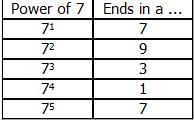
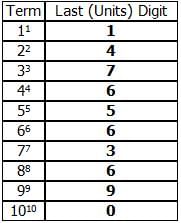

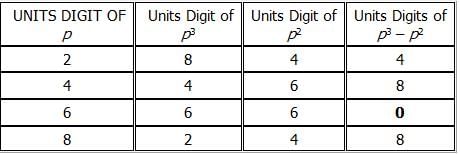 Only when the units digit of p is 6, is the units digit of p3 – p2 equal to 0.
Only when the units digit of p is 6, is the units digit of p3 – p2 equal to 0.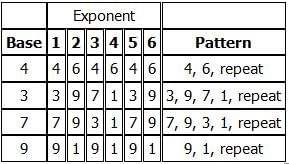

 , what is the units digit of
, what is the units digit of 


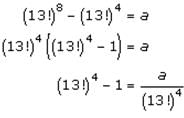
 is 9. The correct answer is E.
is 9. The correct answer is E.

















